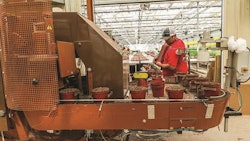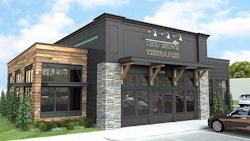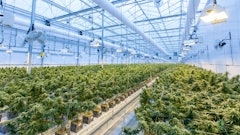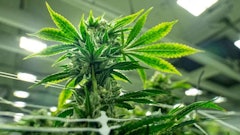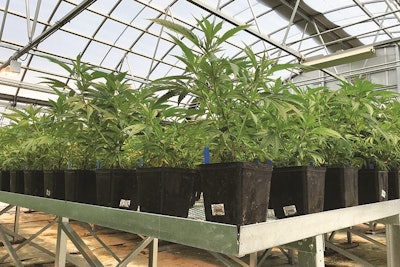

Someone recently posed the question to me: What type of cultivation and extraction facility would you build today if you had an unlimited budget?
On the surface, it seems like a straightforward query: I could list a few manufacturers and technologies that I would like to use, develop a plan to produce and process efficiently without compromising quality, and ballpark a cost to complete such a project.
But the truth is, so much more goes into facility design than the factors listed above. Accelerated investment in cannabis production and extraction equipment technology, and the mercurial nature of consumer demands certainly muddy the waters. How can you know what is best to build when the cannabis industry changes so quickly?
The answer, ironically, is to ask even more questions. Here are nine of the most common questions clients ask me regarding facility design, along with the dozens of additional questions I pose to them to help them make the best decisions for optimal productivity, quality and efficiency.
Question 1: What lighting should I use?
Do you want to use light-emitting diode (LED) fixtures or high-pressure sodium (HPS) fixtures? Ceramic metal halide? Sodium halide? Should they have dimmable capacity and/or spectrum adjustability? What is the preferred spectrum? What is the UV-B output? What is a particular fixture’s efficiency? What is its heat output? Are there rebate possibilities from the utility company?
Even a simple undertaking like selecting a lighting type can quickly turn into an overwhelming barrage of questions, and like my idea of an ideal facility, lighting depends on your situation and what is available.
It’s important to follow lighting manufacturers’ upgrades and new technologies on the market, as rapid technological innovation has taken place over the past five years. These refined technologies have been developed with a specific focus on cannabis production. This is unprecedented for an industry whose equipment was once based on outdated technologies, such as inefficient bulbs with little to no supporting evidence that they produced superior quality cannabis. Previously, as an underground industry, we simply purchased what was available and had to blindly trust a manufacturer’s claims, with no recourse if the advertised results were inaccurate.
However, in today’s environment, major incentives exist to utilize these latest technologies. Some of those new manufacturers (and products) are untested in a commercial-scale application, but many others have performed or are currently performing real-world testing and trials of cultivation equipment and technologies.
(Editor’s note: For more insight into cultivators’ lighting choices, see Cannabis Business Times’ “State of the Cannabis Lighting Market” report, published in the November 2018 issue.)
Question 2: What should my cultivation method be?
Should you utilize no-till raised beds or containers? If containers, what size do you plan on using at each growth stage? There can be large differences in how a root system develops in a 5-gallon container compared to a 15-gallon container. Will you be growing small plants or large plants? What medium do you plan to use? If you choose soil, what amendments are you going to incorporate? For example, the decision to utilize unsterilized soil or compost as an amendment to an organic medium could risk pest or disease infection, which could be difficult to eliminate or control. Are you considering inert media like rockwool cubes, rockwool slabs, coco fiber (aka coir) in pots, coco fiber cubes or coco fiber slabs? If you intend to grow organically, what type of beneficials do you plan on using?
If environmental impact is a concern, you might consider the carbon footprint of your choice. For example, most rockwool and coco fiber products are foreign-produced and shipped to the U.S. market and, as a result, will increase your carbon footprint.
Meanwhile, some states require that all soil/media used in cannabis cultivation be rendered unusable before being sent to a landfill (meaning it can’t be donated to a local community garden or for another purpose). It’s important to check your state regulations before making any growing medium choice.
Question 3: Should I grow on a single-tier or multi-tiers (vertical cultivation/using more than one level of racks/shelves)?
You’ll need to consider which is most efficient with respect to both space and labor. Are you planning on using two-tier rolling benches to maximize floor space? If you have a 10-acre greenhouse with one grow level, should you move plants from one bay to the next? Should you adjust light levels in each bay to meet the growth stage need? If using a multi-tier system, how are employees going to reach the upper levels?
Very efficient vertical wall space methods have been popping up in the market as of late. When considering these vertical systems, ask yourself, “Are these really more efficient, or just efficient at maximizing floor space?” In other words, is the increase in labor cost and equipment needs worth the increase in canopy? The answer depends on your exact situation.
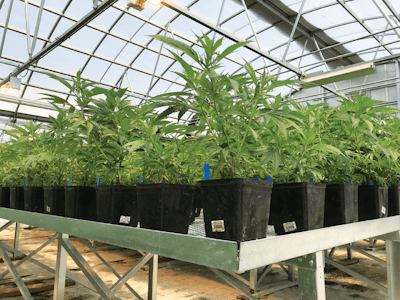
Question 4: What type of irrigation should I use?
First, you’ll need to determine: What is your medium? Will you be doing hydroponics or aeroponics? How dense is your canopy? How large are your flower rooms? Do you plan to have dedicated rooms for each cultivar or multiple varieties growing side-by-side? When all is said and done, which method will be most ecological and efficient in upfront cost and maintenance cost? Which method is most suitable to help you scale? Should you invest in drip irrigation and emitters, or an ebb-and-flow system, as some tomato growers do? Should you utilize overhead boom sprayers for seedling trays in a greenhouse?
Irrigation can give even the most experienced cultivators and facility designers a headache. Given that every environment slightly differs and every situation has different logistics and labor availability, there is a lot to factor in when it comes to irrigation, including water sourcing, whether you need a reverse osmosis (RO) system, and what type of irrigation lines you will need to carry those fluids across your facility.
Question 5: What environmental controls should I use?
What HVAC system should you use? Which type of water-chilling system should you use? What method of powdery mildew control will be most suitable for your operation? How will you control your humidity levels in daytime and nighttime? How will you control temperatures?
In this area, look to current greenhouse agricultural practices. Greenhouse Management magazine (CBT’s sister publication at GIE Media) has been a wealth of information to me for many years. There are many manufacturers to choose from regarding environmental controls and HVAC. Some have designed equipment for the agricultural market for many years and often know exactly what is needed to efficiently control any indoor environment or greenhouse. Again, the choice depends on what you will need and what is available.
Question 6: What automation should I introduce to my grow?
A number of key considerations exists regarding automation. Will you need conveyor belts to move plants? Do you plan to use drip irrigation instead of hand-watering? Do you want to automate your trimming?
When thinking of which aspects of large-scale production need to be automated, again, turn to commercial agriculture. The same basic needs of cultivating plants such as tomatoes or poinsettias in mass quantities also apply to cannabis cultivation.
Many very productive uses exist for automation in many different areas of the cannabis cultivation and harvesting process. The key is to choose which components allow you to efficiently maximize production and properly utilize labor to achieve your desired results. For example, it may be preferable to have a machine plant a million plants or seeds rather than have humans plant them.
Question 7: What eco-friendly processes should I look into?
Questions to ask here are: Are your pots made of recycled plastic? What about your packaging? Are your vape pen cartridges made of eco-friendly materials?
Look at all the inputs you are using to cultivate and process cannabis and ask yourself if there is a more eco-friendly option. To curb your energy use, you can consider utilizing efficient, zero-waste power generators, such as the Jenbacher power generator. Or perhaps you can leverage wind or solar power electricity generators and batteries to cut back your electrical grid use during high-rate/peak usage hours. Do your research and get creative with how you can feasibly incorporate these power sources into a production facility efficiently, all while being cost effective.
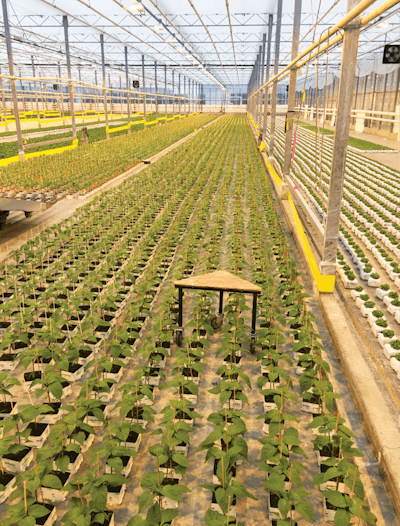
Question 8: What nutrients and amendments should I use to feed my cannabis crops?
Here, other questions will overlap to help you arrive at an answer. What irrigation methods are you planning on utilizing? Are you planning on using organic inputs, non-organic inputs or both? Are you considering salt-based fertilizers? Are you using a hydroponic/aeroponic system or a soil-based medium? Is the medium you chose inert or organic-based?
You might be inclined to think that if you prefer organic food, you should produce organic cannabis. But organic practices in an indoor or greenhouse environment can create a potential for infection of pests and diseases for which the only organic methods of control are for just that—control, not complete elimination of the problem. When growing organically, you will want to prevent pests and disease instead of treating them, and that involves introducing healthy populations of beneficial insects, or the application of safe compounds, such as neem oil.
As such, you may prefer non-organic methods as an added measure to stave off infection.
Salt-based fertilizers are also better suited for using in drip irrigation systems, as they avoid the clogging issue that can sometimes occur with organic nutrients (which then requires more preventative maintenance/cleaning). Worth considering, however, is that organic fruits and vegetables fetch a higher market price because consumers often will pay more for organic products, and many anticipate this same market trend to advance in cannabis.
Question 9: What extraction equipment should I invest in?
Do you want to create CO2 extracts, butane extracts and/or ethanol extracts? Are you planning on doing a more labor-intensive dry-sieve? Do you want to press hash?
The rapid acceleration of equipment innovation and availability never ceases to amaze. If you were to attend a cannabis event each month, you would witness the live competition to innovate, invent and perfect multiple extraction apparatuses by dozens of companies. There are many extraction equipment manufacturers to choose from, and each one is focused on giving you high-quality and efficient extraction capabilities. So, which is the best? It depends on your desired final product, and the method in which is required to produce that product efficiently.
Beyond that, you should examine each method’s energy consumption and labor requirements, the required time it takes to produce a given amount of extract and the yield of extract relative to the plant weight you are processing. Also, consider all ancillary costs such as CO2 or solvent refueling and storage, compliance costs for production facilities and the cost of all materials and inputs required to produce your desired final product on a commercial scale. (Editor’s note: For more on extraction methods, see the August 2018 and September 2018 Tomorrow in Cannabis columns.)
The Payoff
This may seem like a lot of questions to answer before you dive head first into your facility design stages; but the benefit of spending adequate time up front determining your ideal cultivation media and methods, as well as your personal priorities, will pay dividends on creating the most ideal facility for your cultivation business at the outset.









